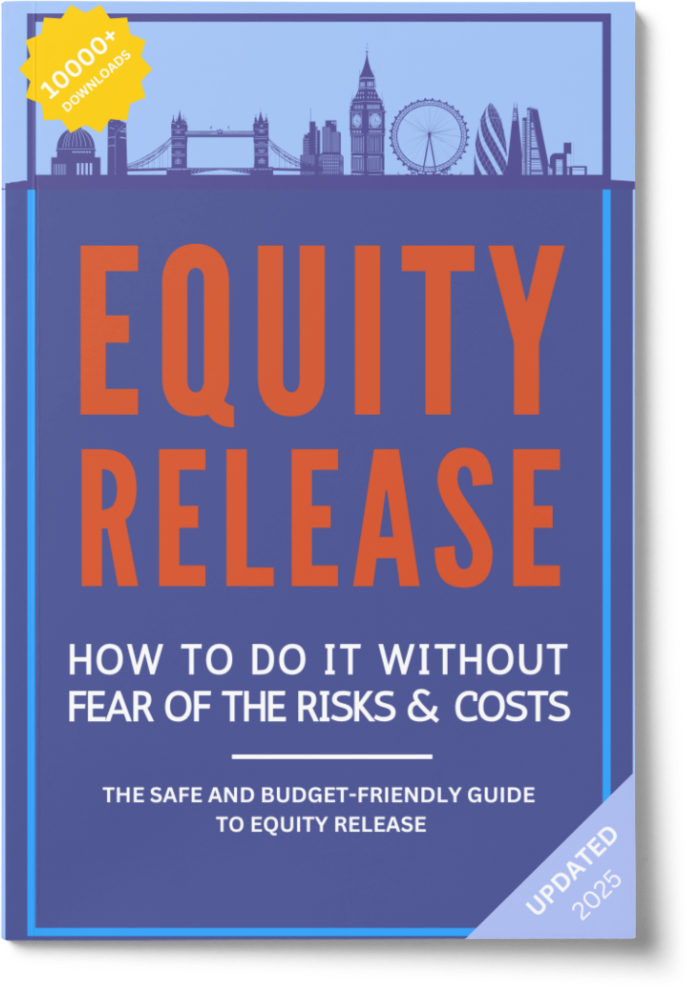How Does Equity Release Work? Read the Details Here

SovereignBoss adheres to a stringent code of editorial guidelines, but some articles may feature partner references. Here is an explanation for how we make money.
- The process of equity release in the UK involves assessing your property's value, consulting with a financial adviser, choosing the suitable plan, and completing the legal paperwork before finally receiving the funds.
- It can be a safe retirement option if properly planned, but understanding its long-term financial implications is crucial as it reduces the value of your estate and might affect your entitlement to certain benefits.
- It offers the benefit of accessing funds tied up in your property without moving, but the downsides include reducing your estate value, potentially impacting your state benefits, and often coming with higher interest rates compared to regular mortgages.
- The amount you can borrow depends on factors like age, property value, and the specific plan you choose, typically ranging from 20-50% of your property's value.
- You can get it if you have an outstanding mortgage, but the funds must first be used to pay off any remaining mortgage balance.
If you want your share of the £6.2bln unlocked in 20221, you may best discover: How does equity release work?
From compound interest to ways to unlock cash, there is much to know about how these plans operate.
Fortunately, we have the perfect introduction to set you on your way.
In This Article, You Will Discover:
Here is what our expert team has to offer on how equity release works.
What Is Equity Release?
Equity release is a financial option available to homeowners aged 55 and over in the UK. It allows you to access the equity tied up in your home without the need to move.
Equity release loans come in two main forms: lifetime mortgages and home reversion plans. Both offer ways for those 55 and older to access home equity without selling.
Lifetime mortgages involve borrowing against your home's value, with no need to repay until you pass away or move into long-term care.
Home reversion, on the other hand, means selling a part or all of your home in return for a lump sum or regular payments, while continuing to live there rent-free.
How is Equity Released?
Releasing equity works by providing homeowners, typically aged 55 or older, with the option to release the cash tied up in their properties without moving out.
This can be done through lifetime mortgages or home reversion plans.
With a lifetime mortgage, a loan is secured against the property, and the homeowner can receive a lump sum or regular withdrawals.
The loan is repaid, along with accumulated interest, when the homeowner passes away or moves into long-term care.
In the case of home reversion, a portion or all of the property is sold to a provider in exchange for a lump sum or regular payments, and the homeowner retains the right to live in the property for the rest of their life, usually rent-free.
A lifetime mortgage is by far the most common form of equity release (over 99% of all loans),2 due to the advantage of retaining ownership.
There are a number of equity release facts that are important to know before making a decision.
How Does Eligibility and Application for Equity Release Work?
Eligibility for equity release primarily depends on your age (usually a minimum of 55 years), the value of your property, and the equity available in it.
Other factors such as your health and lifestyle may influence the amount you can release.
Further factors
The building type and state of your property will also influence your eligibility for equity release products.
The application process generally involves the following steps:
- An initial consultation with an advisor
- A financial assessment
- Property valuation
- Legal counseling
- The release of funds
An adviser or broker will assist you throughout these stages, helping you understand the commitments involved, and providing a clear explanation of both the benefits and risks associated with equity release.
They will also be able to determine whether equity release is the most suitable option for your circumstances compared to any alternatives.
It is crucial to thoroughly consider the risks and implications before proceeding with the equity release process.
How Does the Process of Choosing an Equity Release Provider Work?
Choosing an equity release provider is a significant decision that should not be taken lightly.
It is always advisable to opt for a member of the Equity Release Council (ERC)3 to ensure you are protected.
Compare several providers and their plans.
Look at the interest rates they offer and any additional features or flexibilities such as drawdown facilities, repayment options, or inheritance protection.
Also consider the provider's customer service, reputation, and transparency about costs and fees.
Always remember
It is important to take your time, involve your family in the decision-making process, and seek independent advice before proceeding.
What is The Equity Release Process and How Does It Work?
The equity release process usually begins with a consultation with a qualified adviser or broker.
The adviser assesses your financial situation, explains your options, and helps you understand if equity release is right for you.
If you decide to proceed, your property is valued, and the maximum equity release is calculated.
You then submit an application to a provider.
Once your application is approved, and the necessary legal processes are completed with your solicitor, you will receive the funds.
The amount can be either a lump sum or an initial lump sum, with the remaining balance placed in a drawdown facility, based on your chosen option.
Managing and Adjusting Your Equity Release Plan: How It Works
Managing an equity release plan often involves regular reviews with your selected adviser.
Most new plans, and some older ones, allow flexibility to make voluntary repayments or to draw additional funds if needed.
Always check with your provider before making significant changes to ensure it does not affect your plan's terms or result in unexpected fees.
How Does Reviewing Your Equity Release Plan Work?
Reviewing your equity release plan typically involves meeting with your adviser to assess your current financial situation.
This review may include checking:
- The interest rate
- Analysing if the plan still fits your needs
- Exploring newer plans on the market
- Considering any changes in property value
- Understanding the potential impact on your estate
How Does Switching Equity Release Plans Work?
Switching equity release plans usually involves repaying your existing plan with the proceeds from a new one.
Taking out a new plan could allow you to access better interest rates, more favourable terms, or better features.
However
There may be early repayment charges involved which could outweigh the benefits of switching.
This highlights the importance of exploring all your options in detail with a qualified equity release advisor who has up-to-date knowledge of the market.
How Does Remortgaging to Release Equity Work?
Remortgaging to release equity involves obtaining funds from an equity release plan and using a portion of those proceeds to settle your existing mortgage.
To qualify for equity release, it is essential that the current mortgage is fully paid off using a part of the equity release funds.
The remaining amount, if any, can then be made available to you as a lump sum or regular withdrawals, depending on the equity release plan chosen.
This process allows you to access the cash tied up in your property while restructuring your mortgage arrangement.
Financial Considerations of Equity Release
Equity release is a long-term financial commitment, so you must consider how it could impact your financial future.
Consider the impact on your estate, the potential reduction in your entitlement to means-tested benefits, and the effect of compound interest on a lifetime mortgage.
Also
Be aware of all associated fees and potential early repayment charges.
How Does Inheritance Planning with Equity Release Work?
Inheritance planning is a vital consideration with equity release, as it reduces the value of your estate, potentially leaving less for your heirs.
If this is a concern, some plans offer inheritance protection, which reserves a portion of your property's value for inheritance.
Discuss your desires with your family, so they may provide input to your decision.
How Does Home Ownership and Equity Release Work?
You will retain full home ownership if you opt for a lifetime mortgage equity release.
For a home reversion scheme, you sell part or all of your property but have the right to live there rent-free (in most cases) for the rest of your life.
Can I Sell My Home If I Have Equity Release?
You may wonder "Can I sell my house with equity release?", and the answer to that is yes, if you meet certain terms and conditions from your lender.
If you have a lifetime mortgage, you can sell your property, and the outstanding loan, along with accumulated interest, will be repaid from the proceeds of the sale.
If you have a home reversion plan, you would typically sell a portion or all of your property to the provider, and they would receive their share of the sale proceeds.
Be aware
Early repayment charges may apply if you decide to terminate the agreement before its scheduled end, depending on the terms of your plan.
It is essential to check the terms and conditions of your specific equity release plan and seek independent financial advice before making any decisions regarding selling your home.
Can I Move House If I Have an Equity Release?
Many equity release plans allow you to move to a new home, subject to the new property meeting your equity release provider's criteria.
There may also be administrative and valuation costs involved in the process.
Common Questions
How Can I Avoid Negative Equity With an Equity Release Scheme?
Is Equity Release Better than Other Financial Products for Retirees?
What Is the Process of Equity Release in the UK?
How Long Does the Process of Valuation, Receiving an Offer, and Receiving Your Money Take?
Should I Involve My Family Members in the Equity Release Decision-Making Process?
How Can I Calculate How Much I Can Borrow With Equity Release?
What Happens if the Property Value Changes Significantly During an Equity Release Scheme?
Can Joint Owners of a Property Take Out an Equity Release Plan?
How Do Providers Assess the Risk and Viability of an Equity Release Plan?
What Happens to an Equity Release Plan if I Need to Move Into Long-Term Care?
Is Equity Release a Safe Option for Retirement?
What Are the Pros and Cons of Equity Release?
How Much Could I Borrow with Equity Release?
Can I Get Equity Release If I Have an Outstanding Mortgage?
In Conclusion
Equity release is a safe and convenient retirement product if done currently and with the guidance of a professional.
Before you embark on your journey, explore your alternatives and do your comprehensive research on ‘How does equity release work?’
WAIT! Before You Start…
Equity Release Calculator
How Much Equity Can You Release?
Spotted a Mistake? Let us know here.




